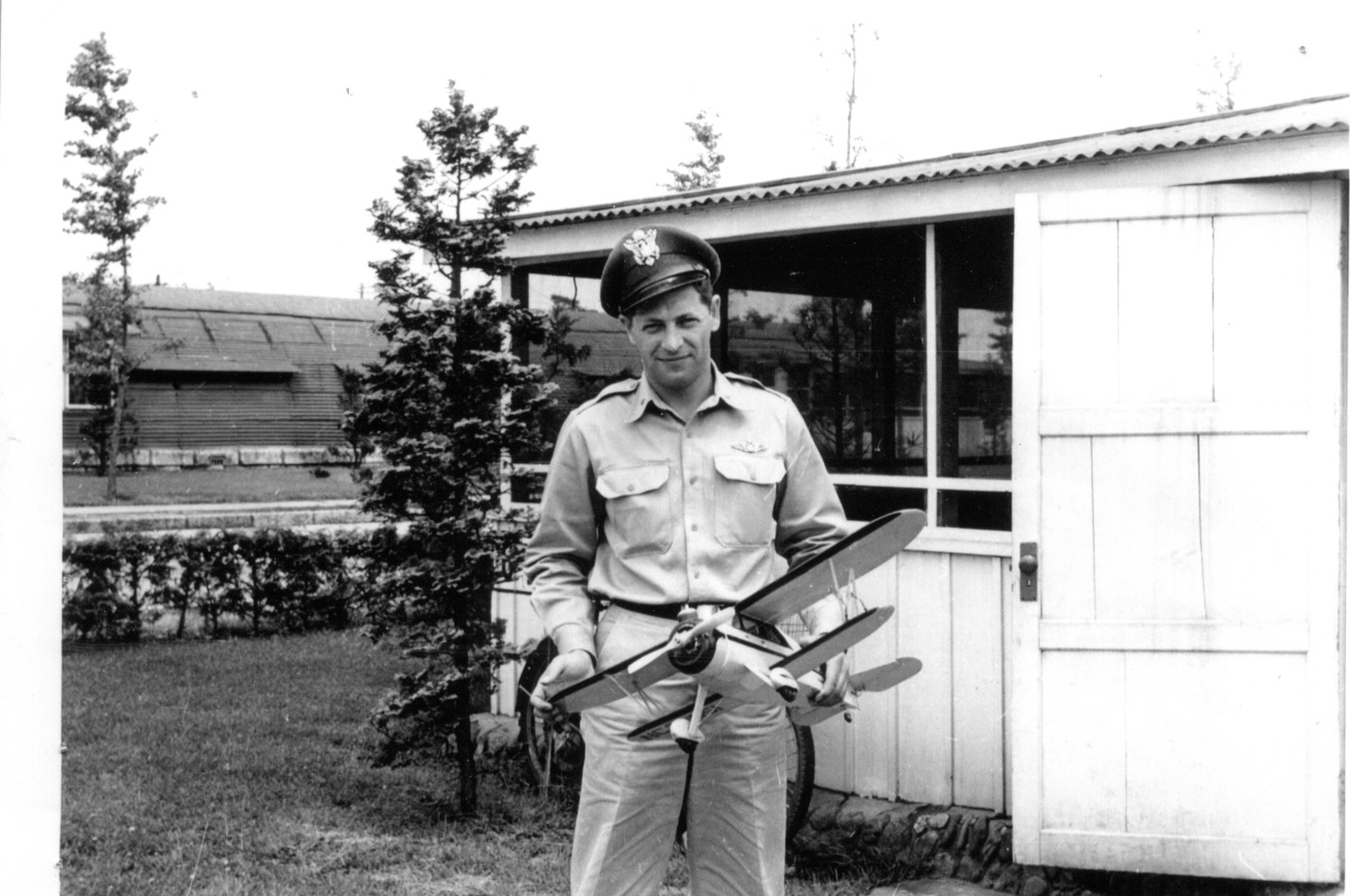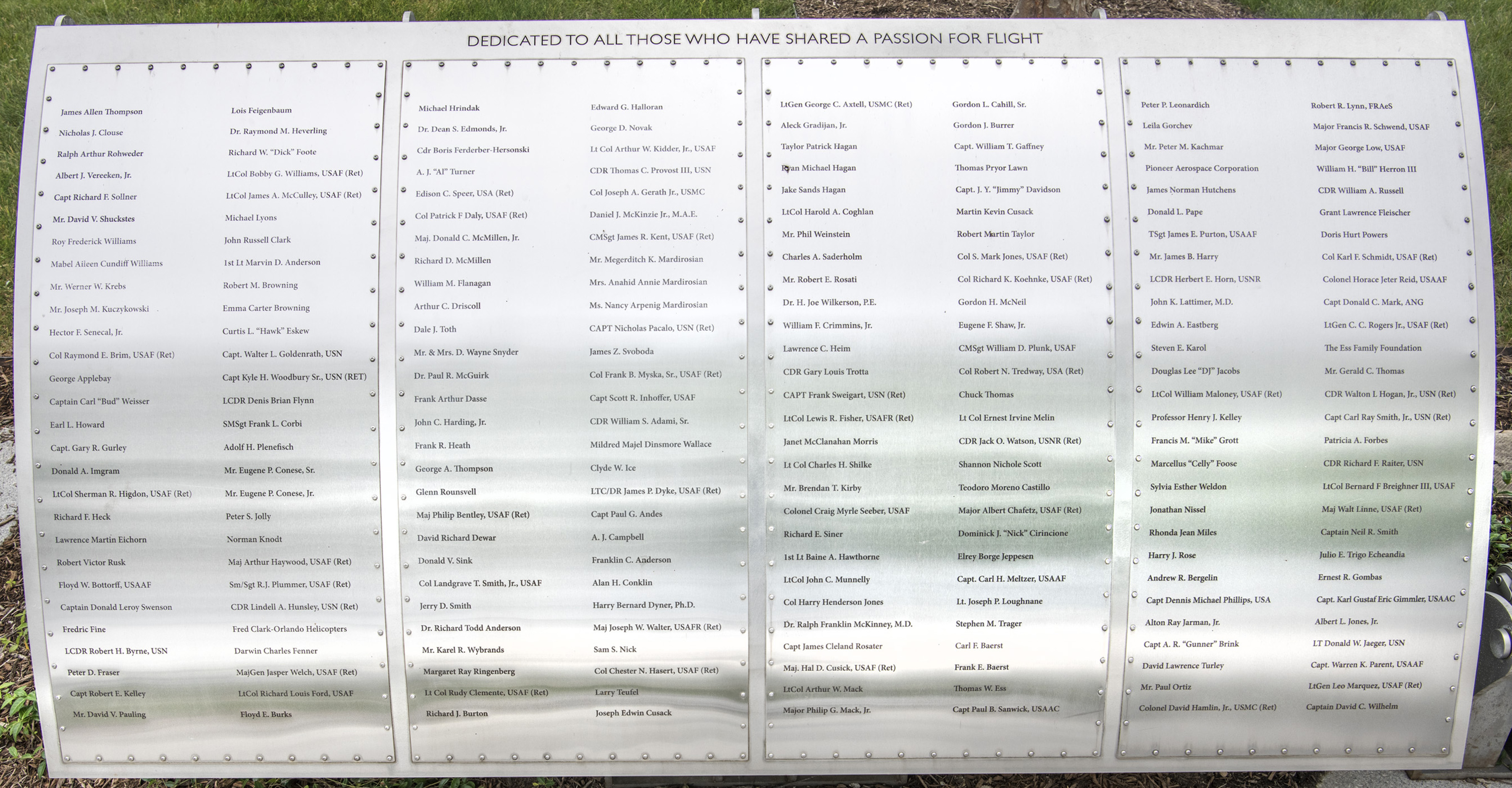
Foil: 27 Panel: 3 Column: 2 Line: 19
Wall of Honor Level: Air and Space Sponsor
Honored by:
Terri N. Herzog
I was 20 years old when, on Nov. 8, 1940, I enlisted in the U.S. Army Air Corps. It was the start of a 21-year military career that would take me from St. Louis to the Philippines, through two wars, from private to major and a life unalterably changed.
From Jefferson Barracks in St. Louis, I was shipped to Hawaii, where I went through boot camp at Hickam Field. I was assigned to the 19th Bomb Group and sent to the motor pool. But airplanes were my passion and fortunately, I was soon transferred to the flight line to train as an aircraft mechanic.
From the time I was a boy carving model airplanes out of balsa wood and devouring dime novels about the flying aces of WWI, I knew exactly what I wanted to be.
My first day on the flight line as an aircraft mechanic, a burly master sergeant serving as the crew chief handed me a rag that was to be my toolbox and told me to wipe all the oil dripping on the airplane. And that was my introduction into aeronautics, far from the glamorous life I envisioned but a start just the same.
We had four B-18 Bombers in our unit and my first ride in an airplane was in the bombardiers nose. When that airplane left the ground, I was hooked.
I was on KP duty on Angel Island in San Francisco Harbor on Dec. 7, 1941. We were dumfounded, a combination of shock and adrenaline, as we watched the freighters head out empty each morning and come back each afternoon with deck guns, ready to head out to sea.
A few days later, I was assigned to Luke Field in Phoenix, Ariz., and the 924th School Squadron, the tow target squadron for gunnery practice. We were equipped with AT6 Airplanes, where I served my first job as crew chief. The squadron was then shipped to Ajo, Ariz., where I became tow operator from the back seat of an airplane.
We had service pilots flying the missions and it was boring going around the range, so they would let me fly from the back seat. It would be my first taste handling the controls of an airplane, and I will never forget it.
In late 1942, I was accepted for flight training and sent to Santa Ana, Calif., for preflight school, assigned to Class 43J. After completing ground school, Saturday inspections and Saturday Parade, I was sent to Visalia, Calif., for primary flight training, where I flew the Ryan PT22 for 60 hours. Having passed all my check rides, I was sent to LaMore, Calif., for basic flight training.
Finally, I would solo.
We were flying the BT15s, a 22-year-old kid manning an aircraft the size of a modern-day 747. I had just soloed for the first time when the Air Corps decided to experiment by taking low-time pilots like myself and putting them in multi-engine airplanes.
We started flying the Curtis AT9, which was a great plane, a hot machine in those days, too hot for low-time pilots. So they brought in the Cessna AT17 and it was "The Bamboo Bomber," as we called it, that we would fly until advanced flight training at Lahunta, Colo. What a great time we had flying the stripped-down but high-performance B25 Bombers.
After receiving our Air Corps wings and being commissioned in the Army Air Corps, I was sent to Monroe, La., for a crash course in Celestial Navigation. From there, it was onto Pensacola, Fla., where I checked out the PBY airplane and received a pleasant surprise. Expecting to be dismissed, we were instead lined up, handed diplomas and pinned with Navy wings.
From Pensacola, I went to Keesler Field, Miss., for crew training, where we picked up a new plane and crew and headed out to the Far East to join the Second Air Sea Rescue Squadron.
I flew many missions through the Philippine Islands, Borneo and Indo China. We were scheduled to go to Okinawa for the invasion of Japan when the U.S. dropped the Atom Bomb and the war ended.
Eager to continue the life I had forged as an air corps pilot, I went to Clark Field in the Philippines and remained there until I returned to the States, separating from the Air Corps as a First Lt. Pilot.
I would join the Air Force Reserve at O'Hare Field in Chicago and checked out in the Curtiss C46, about six months before the Korean War began on June 25, 1950.
We were on our two-week summer active duty, encamped at O'Hare, when rumors began to swirl that we would be called to active duty. At the end of our tour, we were called together by our commanding general, who told us there was no truth to the rumor and that we should "Go home and pick up where you left off."
I was having dinner with my mother in our apartment in Humboldt Park after my first day of work at an auto parts store, when Western Union delivered my orders to report for active duty in 10 days. When I heard the doorbell and the messenger holler, "Western Union," I knew the rumors were true.
The 437 Troop Carrier Wing was activated and shipped to Shaw Field, N.C., for training. It was there where we would pick up our re-built airplanes and head to Japan.
When we arrived in Japan, our troops were at the Yalow River, but we were told the war was over and that we would be going back home. Little did we know that the Chinese would soon cross the river.
To come to the aid of the North Koreans, we started flying to the Hamhung Beach Head to airlift the wounded and survivors from the Chosen Reservoir. We flew long hours and under terrible conditions until all the marines were evacuated to Japan.
I would fly missions down the Korean Peninsula and back up the Peninsula until I logged enough flight hours to return to the States and my new assignment at Mitchell Field on Long Island, N.Y.
Upon leaving active duty in 1952, and going back home to Chicago, I returned to active reserve, where I was promoted to captain and served at the Squadron Operations Office at O'Hare. Prior to retirement in 1961, I was promoted to Major.
In May of 2005, my wife Ellyn and I plan to celebrate our 50th wedding anniversary on a Caribbean cruise with our three children, Richard, Wendy and Terri, their spouses Galina, Ricky and Daniel, and our five grandchildren Jacob, Emily, Melissa, Sam and Charlie.
It is through their loving gift that I submit this profile.
Wall of Honor profiles are provided by the honoree or the donor who added their name to the Wall of Honor. The Museum cannot validate all facts contained in the profiles.
Foil: 27
